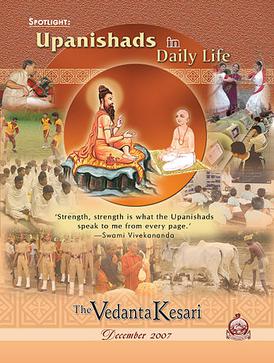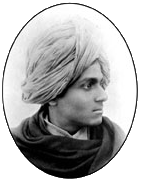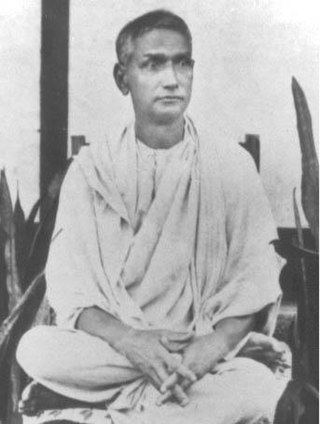
Ramakrishna Math and Ramakrishna Mission (RKM) is a spiritual and philanthropic organisation headquartered in Belur Math, West Bengal. The mission is named after the Indian Hindu spiritual guru and mystic Ramakrishna. The mission was founded by Ramakrishna's chief disciple Swami Vivekananda on 1 May 1897. The organisation mainly propagates the Hindu philosophy of Vedanta–Advaita Vedanta and four yogic ideals – Jnana, Bhakti, Karma, and Raja yoga. The mission bases its work on the principles of Karma Yoga, the principle of selfless work done with a dedication to God.

Swami Shivananda (1854–1934), born Tarak Nath Ghosal, was a Hindu spiritual leader and a direct disciple of Ramakrishna, who became the second president of the Ramakrishna Mission. His devotees refer to him as Mahapurush Maharaj. Shivananda and Subodhananda were the only direct disciples of Ramakrishna to be filmed. He was a Brahmajnani. Shivananda introduced the celebration of the birthdays of his brother-monks. He was known to have laid the foundation stone of Shri Ramakrishna Temple at Belur Math, which was designed by Vijnanananda.
Swami Vireshwarananda, the tenth President of the Ramakrishna Math and Ramakrishna Mission, was born on 31 October 1892 at Gurupura, Near Mangalore, South India. His pre-monastic name was Pandurang Prabhu; he was later known as Prabhu Maharaj. After his father's death at an early age, his mother moved with them to his maternal uncle's house at Mangalore.

Swami Yatiswarananda was a vice-president of Ramakrishna Order, whose headquarter is in Belur Math. He was a disciple of Swami Brahmananda, a brother disciple of Swami Vivekananda and a direct disciple and spiritual son of Ramakrishna. He served in Philadelphia propagating the message of Vedanta. He was the president of Bangalore centre of Ramakrishna Math. He founded an ashrama in Switzerland.
Swami Nikhilananda (1895–1973), born Dinesh Chandra Das Gupta was a direct disciple of Sri Sarada Devi. In 1933, he founded the Ramakrishna-Vivekananda Center of New York, a branch of Ramakrishna Mission, and remained its head until his death in 1973. An accomplished writer and thinker, Nikhilananda's greatest contribution was the translation of Sri Sri Ramakrishna Kathamrita from Bengali into English, published under the title The Gospel of Sri Ramakrishna (1942).

Swami Virajananda, born Kalikrishna Bose, was an initiated disciple of Sarada Devi and the sixth president of the Ramakrishna Order. Born as the son of Trailokyanath Bose and Nishadkalidevi, Virajananda was the first person to join the Ramakrishna Order after the direct disciples of Ramakrishna. In 1897, he was initiated into sannyasa by Vivekananda. From 1899 onward he served in Advaita Ashrama, Mayavati and became its president in 1906. He is recognised as a monastic disciple of Vivekananda.

Ramakrishna Math is the administrative legal organization of the Ramakrishna Order, considered part of the Hindu reform movements. It was set up by sanyasin disciples of Ramakrishna Paramhansa headed by Swami Vivekananda at Baranagar Math in Baranagar, a place near Calcutta, in 1886. India. The headquarters of Ramakrishna Math and its twin organisation, Ramakrishna Mission is at Belur Math.

Swami Gahanananda, the 14th President of the Ramakrishna Order, was born in the village of Paharpur in Sylhet District in October 1916. Known as Naresh Ranjan Roy Choudhury in his pre-monastic days, he joined the Ramakrishna Order at its centre in Bhubaneswar in January 1939 at the age of 22. He received initiation in 1939, brahmacharya in 1944 with the name 'Amrita-chaitanya' and Sannyasa from Swami Virajananda Maharaj, the then-President of the Order. He was greatly influenced by the dedicated lives of some of the monks of Ramakrishna Order, especially Swami Prabhananda, who was his cousin in his pre-monastic life. He had also once met Swami Abhedananda, a direct disciple of Ramakrishna. He served at the Advaita Ashrama, Kolkata, from 1942 to 1952 and at Shillong centre from 1953 to 1958.

Prabuddha Bharata is an English-language monthly journal of the Ramakrishna Order, in publication since July 1896. It carries articles and translations by monks, scholars, and other writers on humanities and social sciences including religious, psychological, historical, and cultural themes. It has a section of book reviews where important publications from university presses from around the world are reviewed. It is edited from Advaita Ashrama, Mayavati, Uttarakhand, and published and printed in Kolkata. Prabuddha Bharata is India's longest running English journal.

Swami Atmasthananda was an Indian Hindu monk, who was the fifteenth president of the Ramakrishna Math and the Ramakrishna Mission.

The Vedanta Kesari is an English language monthly magazine covering spiritual and cultural issues, published by the Ramakrishna Math in Chennai, India, since 1895.

Advaita Ashrama, Mayavati, is a branch of the Ramakrishna Math, founded on 19 March 1899 at the behest of Vivekananda, by his disciples James Henry Sevier, and Charlotte Sevier. Today it publishes the original writings of Vivekananda. As an ashram dedicated to the study and practice of Advaita Vedanta, no images or idols are worshipped there, not even of Ramakrishna; and no images were kept in the premises according to the Ashram ideals set by Vivekananda.

Ramakrishna (1836–1886) was an Indian Bengali Hindu mystic. Born as he was during a social upheaval in Bengal in particular and India in general, Ramakrishna and his movement—Ramakrishna Mission—played a leading role in the modern revival of Hinduism in India, and on modern Indian history.

Swarupananda was a direct monastic disciple of Vivekananda and the first president of the Advaita Ashrama, set up by Vivekananda in 1899 at Mayavati, near Champawat. The ashram is a branch of the religious monastic order, Ramakrishna Math, also set up by Vivekananda on the teachings of his guru Ramakrishna.

Swami Ashokananda, born as Yogeshchandra Dutta, was a disciple of Swami Vivekananda of India and a monk of the Ramakrishna Math. From 1932 until his death in December 1969 at the age of 76 he was in charge of the Vedanta Society of Northern California, San Francisco.

Nirmalananda, born as Tulasi Charan Dutta in Calcutta, was a direct disciple of Ramakrishna, the 19th-century mystic and Hindu saint from India, and took Sanyasa from Vivekananda along with Brahmananda and others. He was initiated by Sri Ramakrishna, on which fact a few latter-day antagonists tried to cast doubt in the Bangalore Court, but into which question the Court refused to get into. Nirmalananda played a key role in establishing Ramakrishna Math and Mission chiefly in South India, in Kerala and Bangalore and Tamil Nadu and also in the USA, Burma and Bangladesh.

Swami Prakashananda (1874–1927) was a monastic disciple of Vivekananda and a monk of the Ramakrishna Order who played a major role in propagating and promoting the Vedanta philosophy and Vivekananda's message in India and America. He came to the US in 1906 to serve under Trigunatitananda, a direct disciple of Ramakrishna at the Vedanta Society of San Francisco, later renamed as Vedanta Society of Northern California, and later became its president.

Balaram Mandir is a temple and a branch of Ramakrishna Mission and Ramakrishna Math located at 7, Girish Avenue, Baghbazar, Kolkata.

Swami Smaranananda was an Indian senior Hindu monk of the Ramakrishna Math and Ramakrishna Mission, and its 16th president. He joined the organization in 1952, and was elected president on 17 July 2017.
Swami Satprakashananda was an Indian philosopher, monk of the Ramakrishna Order, and religious teacher.
















